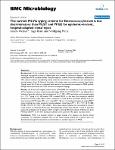The current MLVA typing scheme for Enterococcus faecium is less discriminatory than MLST and PFGE for epidemic-virulent, hospital-adapted clonal types
Werner, Guido
Klare, Ingo
Witte, Wolfgang
Background: MLVA (multiple-locus variable-number tandem repeat analysis) is a reliable typing technique introduced recently to differentiate also isolates of Enterococcus faecium. We used the established VNTR (variable number of tandem repeats) scheme to test its suitability to differentiate 58 E. faecium isolates representing mainly outbreaks and clusters of infections and colonizations among patients from 31 German hospitals. All isolates were vancomycin-resistant (vanA type). Typing results for MLVA are compared with results of macrorestriction analysis in PFGE (pulsed-field gel electrophoresis) and MLST (multi-locus sequence typing). Results: All 51 but one hospital isolates from 1996–2006 were assigned to the clonal complex (CC) of epidemic-virulent, hospital-adapted lineages (MLST CC-17; MLVA CC-1) and differed from isolates of sporadic infections and colonizations (n = 7; 1991–1995) and other non-hospital origins (n = 27). Typing of all 58 hospital VRE revealed MLVA as the least discriminatory method (Simpson's diversity index 0.847) when compared to MLST (0.911) and PFGE (0.976). The two most common MLVA types MT-1 (n = 16) and MT-159 (n = 14) combined isolates of several MLST types including also major epidemic, hospital-adapted, clonal types (MT-1: ST-17, ST-18, ST-280, ST-282; MT-159: ST-78, ST-192, ST-203). These data clearly indicate that non-related E. faecium could possess an identical MLVA type being especially critical when MLVA is used to elucidate supposed outbreaks with E. faecium within a single or among different hospitals. Stability of a given MLVA profile MT-12 (ST-117) during an outbreak over a period of five years was also shown. Conclusion: MLVA is a suitable method to assign isolates of E. faecium into distinct clonal complexes. To investigate outbreaks the current MLVA typing scheme for E. faecium does not discriminate enough and cannot be recommended as a standard superior to PFGE.
No license information
Related Items
Show related Items with similar Title, Author, Creator or Subject.
-
2015-09-15ZeitschriftenartikelErratum to: Investigating the mobilome in clinically important lineages of Enterococcus faecium and Enterococcus faecalis Mikalsen, Theresa; Pedersen, Torunn; Willems, Rob; Coque, Teresa M.; Werner, Guido; Sadowy, Ewa; Schaik, Willem van; Jensen, Lars Bogø; Francia, María Victoria; Sundsfjord, Arnfinn; Hegstad, Kristin
-
2015-04-10ZeitschriftenartikelInvestigating the mobilome in clinically important lineages of Enterococcus faecium and Enterococcus faecalis Mikalsen, Theresa; Pedersen, Torunn; Willems, Rob; Coque, Teresa M.; Werner, Guido; Sadowy, Ewa; Schaik, Willem van; Jensen, Lars Bogø; Sundsfjord, Arnfinn; Hegstad, KristinBackground: The success of Enterococcus faecium and E. faecalis evolving as multi-resistant nosocomial pathogens is associated with their ability to acquire and share adaptive traits, including antimicrobial resistance ...
-
2016-11-28ZeitschriftenartikelDetection of a cfr(B) Variant in German Enterococcus faecium Clinical Isolates and the Impact on Linezolid Resistance in Enterococcus spp. Bender, Jennifer K.; Fleige, Carola; Klare, Ingo; Fiedler, Stefan; Mischnik, Alexander; Mutters, Nico T.; Dingle, Kate E.; Werner, GuidoThe National Reference Centre for Staphylococci and Enterococci in Germany has received an increasing number of clinical linezolid-resistant E. faecium isolates in recent years. Five isolates harbored a cfr(B) variant ...

